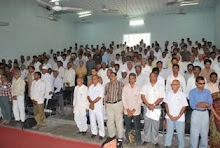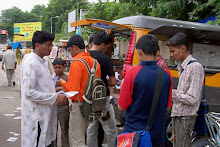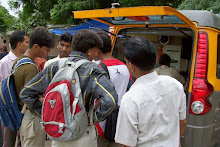Firstpost: National: Thursday, June 21, 2018.
In an amber
lit, cosy space at the G5A Foundation for Contemporary Culture in Mumbai, RTI
activist and author Aruna Roy unveiled her latest book titled 'The RTI Story:
Power to the People' along with activist and former Central Information
Commissioner, Shailesh Gandhi. The book launch was a partnership between
Literature Live! which is a platform for literary events and Roli Books, the
publishers. Wrapped in an eco-friendly bag, the book was unveiled by the
activists to a packed room and an enthusiastic audience.
The book
contains accounts of a long journey and the struggles which the National
Campaign for People's Right to Information (NCPRI) and the Mazdoor Kisan Shakti
Sangathan (MKSS) faced to campaign for the right to information and a
transparent democracy in practice. Retired IAS officer and diplomat
Gopalkrishna Gandhi, who has penned the foreword, also mentions the constant
risks faced by people who dare to speak out.
After the
unveiling, both the activists were invited on stage for a conversation about
India's biggest people's participatory movement which resulted in the formation
of a rights-based law that is the Right to Information Act of 2005. Shailesh
Gandhi told the audience the book rightly conveys the origin and shaping of the
RTI movement. Gandhi quizzed Roy about how the movement began and Roy recounted
the time when members of the MKSS started a dharna in a small town in
Rajasthan, Beawar. MKSS was fighting for minimum wages for labourers who were
told that they did not exist on the records, in spite of working for eight
hours. She recalled how small Dalit farmers realised the futility of hunger
strikes and the urgency of demanding records which would remove the 'liars' tag
they'd been labelled with.
"Due to
the movement, they began to understand where the fault lines are or more
accurately, where to pinch the system. All the stories and experiences in the
book have come from living and being with the people. We were fighting for the
records to come out. That's how the concept of RTI was born," stressed
Roy.
When asked
about the significance of Beawar in the RTI movement, Roy lit up and described
how the town got together and joined the campaign against corruption and the
right to information. In 1995, after the government failed to give access to
bills, vouchers and photocopies despite assurances by chief minister Bhairon
Singh Shekhawat, the campaigners gave the government a whole year to make good
on its promises. But when government still failed to do so, the campaign moved
with a huge rally to Beawar's market place, where a dharna began.
"For the
40 days that we sat there, the whole city got together with us. People gave us
keys to their homes, we collected cash in small amounts, the dharamshalas
opened so there was access to bathrooms, the grocery sellers would give us
vegetables and somebody would buy us water. But the story I like best is, the
female member of the local corporation who came to me and said, 'You better win
this and achieve right to information. Hum toh satta khele hai, par mera paisa
tumhare upar hai!'" Roy finished as the audience burst into laughter.
When probed
about the key players in shaping the RTI Act, Roy stated how the principles
were shaped by the struggle but the law was drafted by legal experts. She
recounted how the first draft was made in the IAS academy where she was invited
by NC Saxena and Harsh Mander, after which the rough draft was presented to the
press council. Roy also mentioned the involvement of activists, journalists,
trade unions and other campaigners who were approached for comments on the RTI
draft document.
Gandhi asked
Roy about the present state of the law, and she replied with an analogy of a
Sufi dervish's ascetic dance where the dancers spin with one arm pointed at
earth and the other at the sky. "RTI is kind of like that, it links the
lowest common denominator with the idea of democracy. It helps to understand
governance and educates citizen's on how to make the government function."
But she also
went to say how the systematic interference with our country's institutions by
the current government is worrisome and the silence from the citizens about
accepting such opaque and secretive functioning even more so. "What are we
afraid of? It is as though out of 100 people, there are two bullies and 98
people are silent because everyone thinks everyone else is a bully!" she
exclaimed.
Towards the
end of the conversation between Gandhi and Roy, she explained how independence
and transparency in various Commissions is paramount for democracy. The duo
then opened the floor for questions from the audience. Roy pointed out how
fighting to protect the Constitution is must and expressed admiration for BR
Ambedkar's foresight about how there'd be divisiveness at every level unless
the weaker sections of society were protected.
In her
parting note, she urged young people to look at issues in depth and marvelled
at India's efforts to maintain democracy. "India has got democracy to work
against all tides, and our rights-based laws have drawn global attention,"
she said. "We have no need to look at numbers, after all only 70 people
started the Dandi March with Gandhi and it became a nationwide movement!"














































































